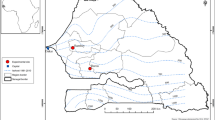Abstract
The use of chemical hybridizing agents (CHA) allows production of hybrid wheat seeds. We evaluated the effectiveness of a new CHA (SC2053) to induce male sterility on winter wheat in controlled growth conditions. CHA effectiveness was measured with the application of 4 doses (0–400–700–1000 g.ha−1) at 7 stages. These stages were defined by the length of the main stem spike (1–4–7–11–15–20–40 mm). At heading, individual ears were isolated with a greaseproof paper bag. The seeds formed were counted on treated and control ears. The spikes' sterility was calculated three weeks after flowering. The sterility of the main stem's spike reached 95% to 100% for application of 700 g.ha−1 and 1000 g.ha−1 for main stem spike length of 7 mm to 20 mm. The effects of ear tillering (5 tillers per plant) on CHA effectiveness were also investigated. We observed a significant delay of ear development between the main stem and tillers so that complete sterilities were not reached for each dose. Since tillering in field conditions rarely exceeds 3 ears per plant, CHA effectiveness was studied on plants bearing 3 ears. The mean sterility of the first 3 ears was close to 100% for applications with 700 g.ha−1 and 1000 g.ha−1 at stages from 11 mm to 20 mm of main stem spike length.
Similar content being viewed by others
References
Batch JJ (1978) Chemical gametocides for wheat and barley in relation to F1 hybrid breeding programmes. Proc. Joint Br. Crop Prot. Conf. and Br. Plant Growth Regul. Group Symp. Opportunities for Chemical Plant Growth Regulation 21: 33–43
Bucholtz DL (1988) Effect of environment and formulation on the absorption and translocation of fenridazon in wheat (Triticum aestivum L.) J. Plant Growth Regul 7: 65–73
Cubitt IR and Curtis FC (1987) Technical progress in the development of hybrid wheat. In: Morton ID (ed) Cereals in a European context, first European conference on food science and technology, pp 55–66. Weinheim: VCH
Dixon GE and Messager B (1987) Emploi de WL 84811 (acide carboxylique-3-azetidine) comme agent chimique d'hybridation sur blé tendre d'hiver. Ann. ANPP, 2° colloque sur les substances de croissance et leur utilisation en agriculture: 41–51
Hughes WG, Bodden JJ and Galanopoulou S (1978) The effect of sowing density and application of gibberellic acid on male sterility and ear emergence in ethephon-treated field-grown wheat. Ann Appl Biol 88: 313–319
Jan CC, Qualset CO and Vogt HE (1974) Chemical induction of sterility in wheat. Euphytica 23: 78–85
Jan CC, Qualset CO and Vogt HE (1976) Chemical induction of sterility in wheat for hybrid seed production. Euphytica 25: 375–386
Jan CC and Rowell PL (1981) Response of wheat tillers at different growing stages to gametocide treatment. Euphytica 30: 501–504
Johnson RR and Brown CM (1978) Use of DPX 3778 to produce hybrid wheat seed. Crop Sci 18: 1026–1028
Jonard P, Koller J and Vincent A (1952) Evolution de la tige et de l'épi chez la variété de blé Vilmorin 27 au cours de la période de reproduction. Ann Am Plant 1: 31–54
Kadam BS (1933) Blooming and anthesis in Kolomba rice. Indian J Agric Sci 3: 577–588
Law J and Stoskopf NC (1973) Further observations on Ethephon (Ethrel) as a tool for developing hybrid cereals. Can J Plant Sci 53: 765–766
Lucken KA (1986) The breeding and production of hybrid wheat. In: Genetic Improvement in Yield of Wheat. Crop Sci Soc Am Pub no 13, pp 87–107.
McRae DH (1985) Advances in chemical hybridization. In: Janick J (ed) Plant breed. Review, 3, pp 169–191. Westport, CT: AVI Publishing Co, Inc
Porter KB, Foster JP, Peterson GA and Worrall WD (1985) Evaluation of chemical hybridizing agent SD 84811 in winter wheat. In: Agr. Abstr Annu Meet. Am. Soc. Agr., Dec. 1–6, Chicago III, 67.
Rowell PL and Miller DG (1971) Induction of male sterility in wheat with 2-chloroethylphosphonic acid (Ethrel). Crop Sci 11: 629–631
Schutz PJ and Almeida E (1988) The effects of chemical hybridizing agents (Sogetal, Inc., Hayward, CA) on the ultrastructure of developing wheat anthers (Triticum aestivum L. var. Yecora rojo). Am J Bot (Abstract) 75: 124
Stoskopf NC and Law J (1972) Some observations on Ethrel as a tool for developing hybrid cereals. Can J Plant Sci 52: 680–683
Tschabold EE, Heim DR, Beck JR, Wright JL, Rainey DP, Terando NH and Schwer JF (1988) LY 195259, new chemical hybridizing agent for wheat. Crop Sci 28(4): 583–588
Thorne GN and Wood DW (1988) Contributions of shoot categories to growth and yield of winter wheat. J Agric Sci Camb 111: 285–294
Virmani SS and Edwards IB (1983) Current status and future prospects for breeding hybrid rice and wheat. Adv Agron 36: 145–214
Wilson JA (1984) Hybrid wheat breeding and commercial seed development. Plant Breed Review 2: 303–319
Author information
Authors and Affiliations
Rights and permissions
About this article
Cite this article
Wong, M., Blouet, A. & Guckert, A. Effectiveness of SC2053 as a chemical hybridizing agent for winter wheat. Plant Growth Regul 16, 243–248 (1995). https://doi.org/10.1007/BF00024780
Received:
Accepted:
Issue Date:
DOI: https://doi.org/10.1007/BF00024780




